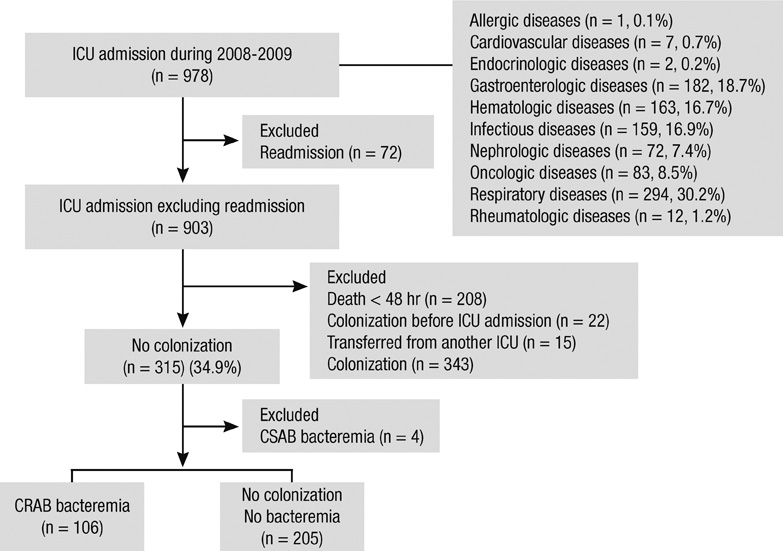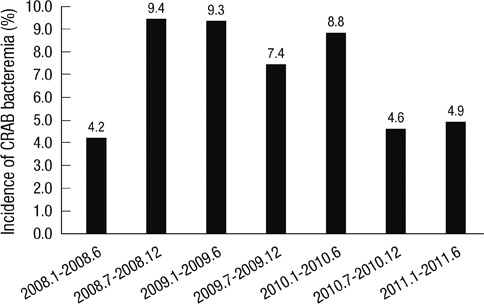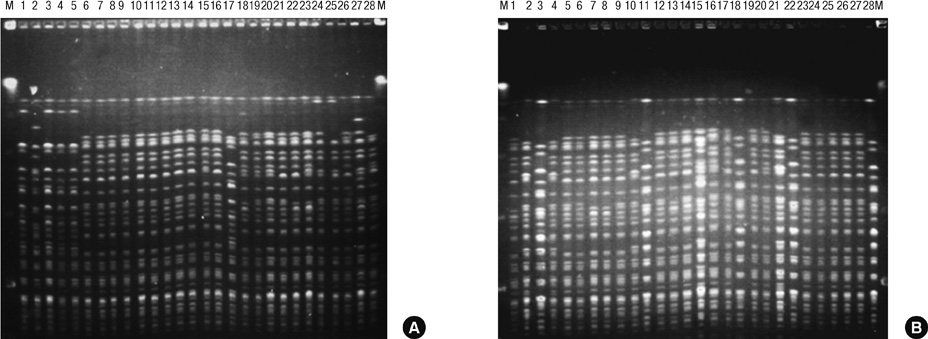J Korean Med Sci.
2012 Aug;27(8):939-947. 10.3346/jkms.2012.27.8.939.
Risk Factors for Occurrence and 30-Day Mortality for Carbapenem-Resistant Acinetobacter baumannii Bacteremia in an Intensive Care Unit
- Affiliations
-
- 1Division of Pulmonology, Department of Internal Medicine, The Institute of Chest Diseases, Yonsei University College of Medicine, Seoul, Korea. pms70@yuhs.ac
- KMID: 1714208
- DOI: http://doi.org/10.3346/jkms.2012.27.8.939
Abstract
- To assess the risk factors for carbapenem-resistant Acinetobacter baumannii (CRAB) bacteremia and for 30-day mortality in patients with CRAB bacteremia in the intensive care unit (ICU), we conducted a retrospective study in the ICU at Severance Hospital in Korea from January 2008 to December 2009. Patients who acquired CRAB bacteremia in the ICU were enrolled as the case group and patients whose specimens of blood culture, sputum/endotracheal aspirate and urine revealed no AB were enrolled as controls. The case group comprised 106 patients and 205 patients were included as controls. Risk factors independently associated with CRAB bacteremia included prior chemotherapy or radiotherapy treatment (Odds ratio [OR], 3.6; P = 0.003), recent central venous catheter insertion (OR, 5.7; P < 0.001) or abdominal drainage insertion (OR, 21.9; P = 0.004), the number of antibiotics treated with (OR, 1.3; P = 0.016), and respiratory failure in the ICU (OR, 2.5; P = 0.035). The 30-day mortality was 79.8%. Renal failure during ICU stay was independently associated with 30-day mortality (OR, 3.7; P = 0.047). It is important to minimize invasive procedures, and to restrict excessive use of antibiotics, especially in immunocompromised patients, in order to prevent the development of CRAB bacteremia. Greater concern for CRAB bacteremia patients is needed when renal failure develops during ICU stay.
Keyword
MeSH Terms
-
Acinetobacter Infections/drug therapy/epidemiology/*mortality
Acinetobacter baumannii/*drug effects
Adult
Aged
Anti-Bacterial Agents/*pharmacology/therapeutic use
Bacteremia/drug therapy/epidemiology/*mortality
Carbapenems/*pharmacology/therapeutic use
Case-Control Studies
Drug Resistance, Multiple, Bacterial
Female
Humans
Immunocompromised Host
Intensive Care Units
Male
Middle Aged
Odds Ratio
Renal Insufficiency/etiology
Retrospective Studies
Risk Factors
Survival Rate
Time Factors
Anti-Bacterial Agents
Carbapenems
Figure
Cited by 1 articles
-
Risk Factors for Mortality in Patients with Acinetobacter baumannii Bacteremia
Se Yoon Park, Jin Woo Choo, Soon Ha Kwon, Shi Nae Yu, Eun Jung Lee, Tae Hyong Kim, Eun Ju Choo, Min Huok Jeon
Infect Chemother. 2013;45(3):325-330. doi: 10.3947/ic.2013.45.3.325.
Reference
-
1. Munoz-Price LS, Weinstein RA. Acinetobacter infection. N Engl J Med. 2008. 358:1271–1281.2. Joly-Guillou ML. Clinical impact and pathogenicity of Acinetobacter. Clin Microbiol Infect. 2005. 11:868–873.3. Souli M, Galani I, Giamarellou H. Emergence of extensively drug-resistant and pandrug-resistant Gram-negative bacilli in Europe. Euro Surveill. 2008. 13:19045.4. Falagas ME, Karveli EA, Siempos II, Vardakas KZ. Acinetobacter infections: a growing threat for critically ill patients. Epidemiol Infect. 2008. 136:1009–1019.5. Heritier C, Poirel L, Lambert T, Nordmann P. Contribution of acquired carbapenem-hydrolyzing oxacillinases to carbapenem resistance in Acinetobacter baumannii. Antimicrob Agents Chemother. 2005. 49:3198–3202.6. Park YK, Peck KR, Cheong HS, Chung DR, Song JH, Ko KS. Extreme drug resistance in Acinetobacter baumannii infections in intensive care units, South Korea. Emerg Infect Dis. 2009. 15:1325–1327.7. Maragakis LL, Perl TM. Acinetobacter baumannii: Epidemiology, antimicrobial resistance, and treatment options. Clin Infect Dis. 2008. 46:1254–1263.8. Jones RN, Sader HS, Fritsche TR, Rhomberg PR. Carbapenem susceptibility discords among Acinetobacter isolates. Clin Infect Dis. 2006. 42:158.9. Perez F, Hujer AM, Hujer KM, Decker BK, Rather PN, Bonomo RA. Global challenge of multidrug-resistant Acinetobacter baumannii. Antimicrob Agents Chemother. 2007. 51:3471–3484.10. Giamarellou H, Antoniadou A, Kanellakopoulou K. Acinetobacter baumannii: a universal threat to public health? Int J Antimicrob Agents. 2008. 32:106–119.11. Poirel L, Nordmann P. Carbapenem resistance in Acinetobacter baumannii: mechanisms and epidemiology. Clin Microbiol Infect. 2006. 12:826–836.12. Baran G, Erbay A, Bodur H, Onguru P, Akinci E, Balaban N, Cevik MA. Risk factors for nosocomial imipenem-resistant Acinetobacter baumannii infections. Int J Infect Dis. 2008. 12:16–21.13. Garcia-Garmendia JL, Ortiz-Leyba C, Garnacho-Montero J, Jimenez-Jimenez FJ, Perez-Paredes C, Barrero-Almodovar AE, Gili-Miner M. Risk factors for Acinetobacter baumannii nosocomial bacteremia in critically ill patients: a cohort study. Clin Infect Dis. 2001. 33:939–946.14. Lee SO, Kim NJ, Choi SH, Kim TH, Chung JW, Woo JH, Ryu J, Kim YS. Risk factors for acquisition of imipenem-resistant Acinetobacter baumannii: a case-control study. Antimicrob Agents Chemother. 2004. 48:224–228.15. Kuo LC, Lai CC, Liao CH, Hsu CK, Chang YL, Chang CY, Hsueh PR. Multidrug-resistant Acinetobacter baumannii bacteraemia: clinical features, antimicrobial therapy and outcome. Clin Microbiol Infect. 2007. 13:196–198.16. Tseng YC, Wang JT, Wu FL, Chen YC, Chie WC, Chang SC. Prognosis of adult patients with bacteremia caused by extensively resistant Acinetobacter baumannii. Diagn Microbiol Infect Dis. 2007. 59:181–190.17. Dijkshoorn L, Nemec A, Seifert H. An increasing threat in hospitals: multidrug-resistant Acinetobacter baumannii. Nat Rev Microbiol. 2007. 5:939–951.18. Dizbay M, Tunccan OG, Sezer BE, Hizel K. Nosocomial imipenem-resistant Acinetobacter baumannii infections: epidemiology and risk factors. Scand J Infect Dis. 2010. 42:741–746.19. Sheng WH, Liao CH, Lauderdale TL, Ko WC, Chen YS, Liu JW, Lau YJ, Wang LH, Liu KS, Tsai TY, et al. A multicenter study of risk factors and outcome of hospitalized patients with infections due to carbapenem-resistant Acinetobacter baumannii. Int J Infect Dis. 2010. 14:e764–e769.20. Zavascki AP, Carvalhaes CG, Picao RC, Gales AC. Multidrug-resistant Pseudomonas aeruginosa and Acinetobacter baumannii: resistance mechanisms and implications for therapy. Expert Rev Anti Infect Ther. 2010. 8:71–93.21. Horan TC, Andrus M, Dudeck MA. CDC/NHSN surveillance definition of health care-associated infection and criteria for specific types of infections in the acute care setting. Am J Infect Control. 2008. 36:309–332.22. Jang TN, Lee SH, Huang CH, Lee CL, Chen WY. Risk factors and impact of nosocomial Acinetobacter baumannii bloodstream infections in the adult intensive care unit: a case-control study. J Hosp Infect. 2009. 73:143–150.23. Garner JS, Jarvis WR, Emori TG, Horan TC, Hughes JM. CDC definitions for nosocomial infections, 1988. Am J Infect Control. 1988. 16:128–140.24. Routsi C, Pratikaki M, Platsouka E, Sotiropoulou C, Nanas S, Markaki V, Vrettou C, Paniara O, Giamarellou H, Roussos C. Carbapenem-resistant versus carbapenem-susceptible Acinetobacter baumannii bacteremia in a Greek intensive care unit: risk factors, clinical features and outcomes. Infection. 2010. 38:173–180.25. Wisplinghoff H, Bischoff T, Tallent SM, Seifert H, Wenzel RP, Edmond MB. Nosocomial bloodstream infections in US hospitals: analysis of 24,179 cases from a prospective nationwide surveillance study. Clin Infect Dis. 2004. 39:309–317.26. Laupland KB, Zygun DA, Davies HD, Church DL, Louie TJ, Doig CJ. Population-based assessment of intensive care unit-acquired bloodstream infections in adults: incidence, risk factors, and associated mortality rate. Crit Care Med. 2002. 30:2462–2467.27. Clinical and Laboratory Standards Institute. Methods for Dilution Antimicrobial Susceptibility Tests for Bacteria That grow Aerobically; Approved Standard. 2008. 8th ed. Wayne, Pa: Clinical and Laboratory Standards Institute.28. Cisneros JM, Reyes MJ, Pachon J, Becerril B, Caballero FJ, Garcia-Garmendia JL, Ortiz C, Cobacho AR. Bacteremia due to Acinetobacter baumannii: epidemiology, clinical findings, and prognostic features. Clin Infect Dis. 1996. 22:1026–1032.29. Ng TK, Ling JM, Cheng AF, Norrby SR. A retrospective study of clinical characteristics of Acinetobacter bacteremia. Scand J Infect Dis Suppl. 1996. 101:26–32.30. Raad II, Hohn DC, Gilbreath BJ, Suleiman N, Hill LA, Bruso PA, Marts K, Mansfield PF, Bodey GP. Prevention of central venous catheter-related infections by using maximal sterile barrier precautions during insertion. Infect Control Hosp Epidemiol. 1994. 15:231–238.31. Choi WS, Kim SH, Jeon EG, Son MH, Yoon YK, Kim JY, Kim MJ, Sohn JW, Kim MJ, Park DW. Nosocomial outbreak of carbapenem-resistant Acinetobacter baumannii in intensive care units and successful outbreak control program. J Korean Med Sci. 2010. 25:999–1004.
- Full Text Links
- Actions
-
Cited
- CITED
-
- Close
- Share
- Similar articles
-
- Clinical Characteristics of Intensive Care Unit Patients with Carbapenem Resistant Acinetobacter Baumannii Isolated from Sputum
- Risk Factors for Mortality in Patients with Acinetobacter baumannii Bacteremia
- Risk Factors for Mortality in Patients with Carbapenem-Resistant Acinetobacter baumannii Bacteremia: Impact of Appropriate Antimicrobial Therapy
- Multidrug-resistant Acinetobacter baumannii infection in the intensive care unit
- Update on the Epidemiology, Treatment, and Outcomes of Carbapenem-resistant Acinetobacter infections




